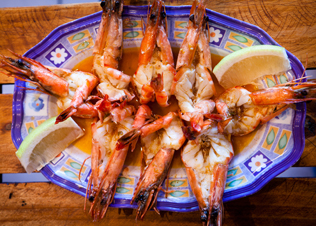News
Eating out for less
Wednesday, April 11th, 2012
“I’ll need your leg as well,” reads the shopkeeper’s speech bubble as a customer passes an arm over the counter at a petrol station. Our inboxes have been full of petrol-price related satire over the past few weeks and one thing’s for sure: we’re all going to be tightening our belts this winter.
Food too, is eating into our budgets. Last December, the Mail & Guardian reported that food prices had increased by 10.6% in 2011, a shocking surge given the fact that they only rose 1% in 2010. Unsurprisingly, eating out is also becoming more expensive, as restaurants are forced to adjust their mark-ups and increase the average price of their main courses.
If you’re not keen on washing the dishes (or donating any limbs), follow our guide to saving money on your restaurant bill.
Do your homework
Check the 2012 issue of Eat Out for a guide to the average main course prices at each of 1000-odd restaurants listed in the magazine. These may change slightly in the course of the year, but can still offer a guide to the kind of price range you can expect when you walk in the door.
Savvy specials
Keep your eyes glued to our specials section, and watch out for blackboards advertising daily specials in your neighbourhood. But don’t be blinded by the word ‘special’. Like ‘sale’, it does not necessarily mean you’re getting a good deal. Can you really eat R150 worth of sushi, or are you likely to keel over before you’ve got your money’s worth from the buffet? Maybe you’re better off ordering off the menu and spending R90 on three great plates of California rolls.
Avoid tourist traps
A great location often equals high rent, so chances are you’ll be paying a premium for that calamari. Our advice? Sip a beer while you watch the sun set and relocate for dinner. Unless it’s winter, that is…
Be a swallow
Great locations are also often seasonal, which mean overworked or new staff and shoddy service and food in summer. Conversely, such restaurants often see a big lull in the winter months and offer fantastic specials. If you’re on a budget, winter is the time to take in that view, or visit that top restaurant you’ve been dreaming of.
Steer clear of the top-end malls
You’d be horrified to hear the rent that some restaurateurs pay in upmarket malls, and naturally, these costs are transferred to you. Older, less shiny malls often hide some real gems run by dedicated owners who don’t have the corporate backing to operate in the top malls. As a result of their location, their overheads are also smaller, and hence, their prices.
Eat ethnic and local
There are times when we all crave fast food, but it might not be the best way to get bang for your buck. In recent years, the pricing gap has been closing, and steak or ribs at some chain restaurants are now more expensive than at independent restaurants. Visit ethnic restaurants and check out our list of neighbourhood gems to find a good-quality alternative. Keeping it local will also help cut your transport costs – and avoid limb-losing petrol expenses.
Watch out for hidden costs
Don’t assume that everything is included. Questions like ‘Which sauce/side/salad would you like with that?’ can be a way to up-sell customers. If anything is unclear, don’t be afraid to ask. You don’t want to discover that the mushroom sauce costs R25 when the bill arrives.
Look at value, rather than price
It might be the cheapest thing on the menu, but do you really want to pay R50 for a Greek salad? Certain dishes carry higher mark-ups than others, so you might well be getting better value with the ostrich steak for R75 – and be saved the horror of food envy.
Share
If you’re heading out in a group of five, order four main courses and share them. Portion sizes are usually far too big for one, and tasting all sorts of different things is fun. The same goes for starters or desserts. Who really has space for a proper three-course meal? Get everyone to order their own main course, and rather share a few starters and desserts.
Order a half portion
The concept of a ‘ladies steak’ might annoy the feminists among us, but when it comes to portion size, it’s often just what ladies – and men – need. Many restaurants offer half portions for reduced prices. Alternatively, stick to a starter.
Bring your own wine
Wine mark-ups can be huge, with some restaurants making up to a 500% mark-up on their vino. True, corkage can also be pricey – there are plenty of restaurants that charge R100 – but there are also some eateries where you’ll pay only R20 to bring your own wine, or where you can even bring one bottle for free. Check out the latest issue of our print magazine for a guide to corkage at the listed restaurants.
Tap water
“Still or sparkling?” is the standard response to a request for a glass of water, but that’s no reason to be bullied into paying for your H2O. Think of the environment and order tap water. Any snobby looks you receive will be forgotten when the bill arrives.
By Katharine Jacobs
Dating on a budget? Check out our list of great dates for under R250.
Pictured here: prawns at Cubata.








